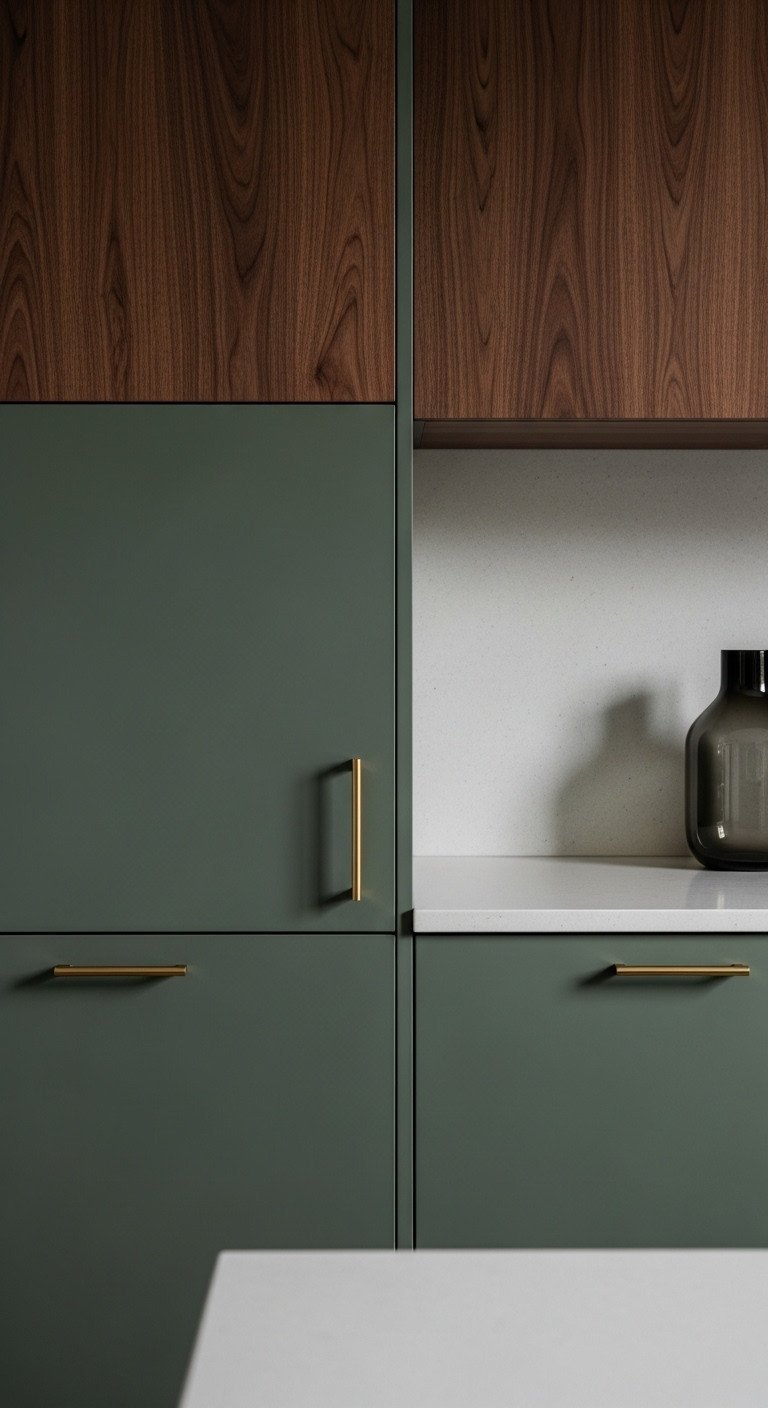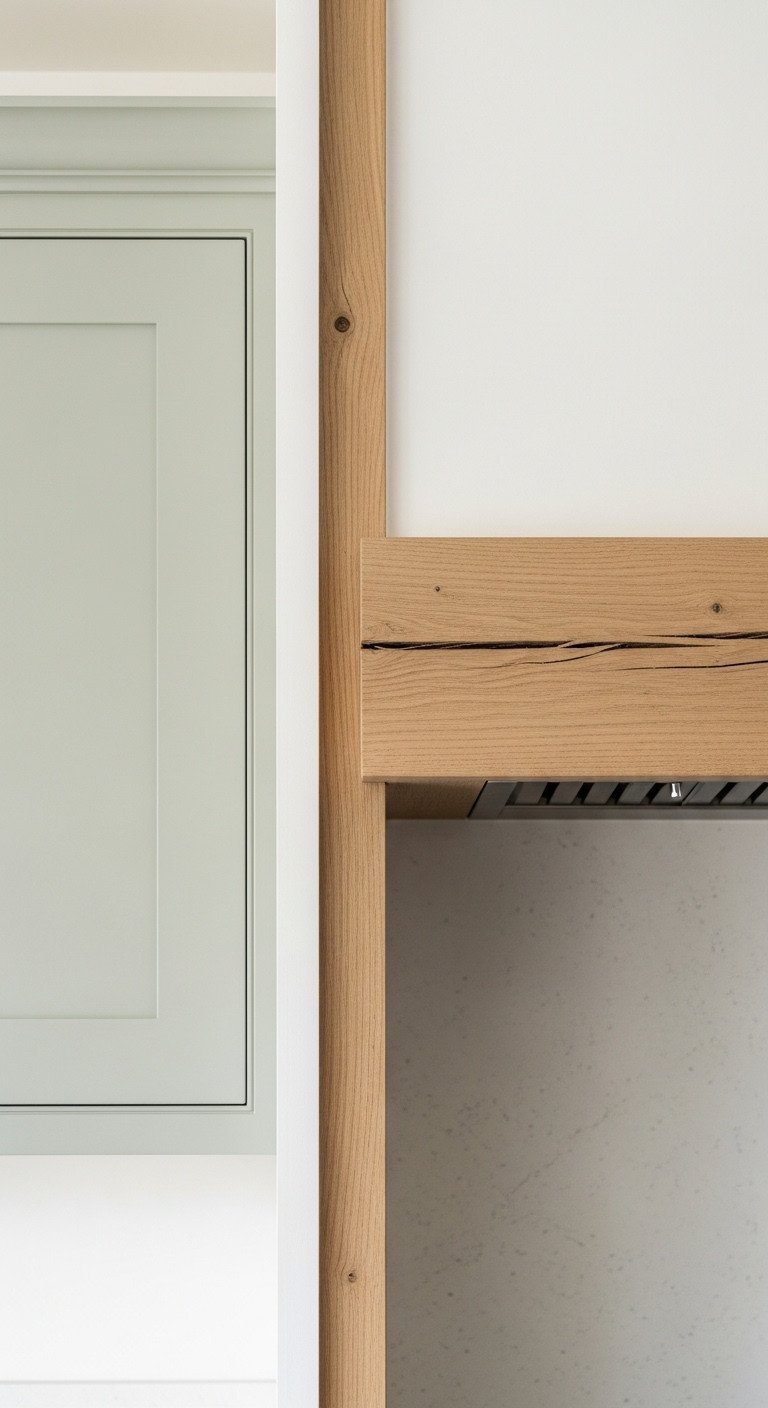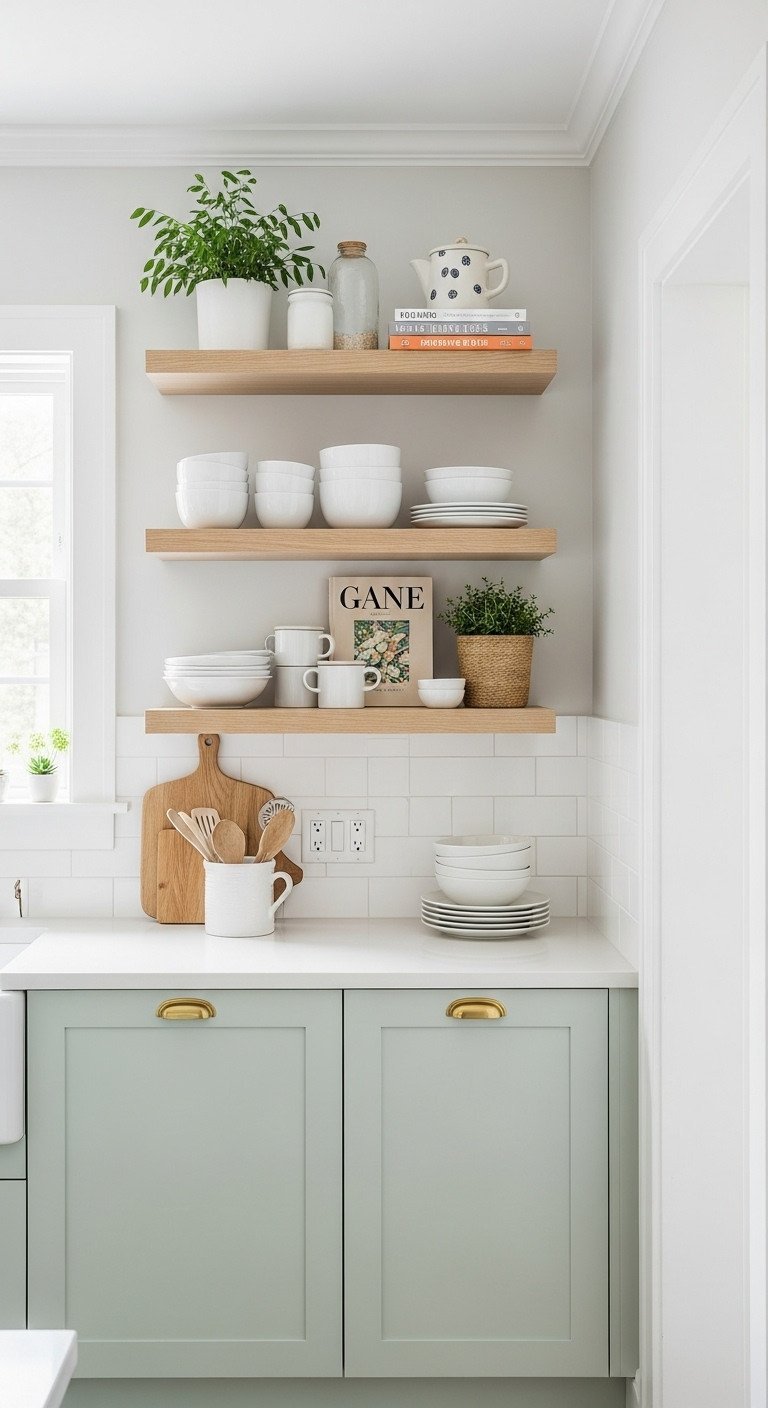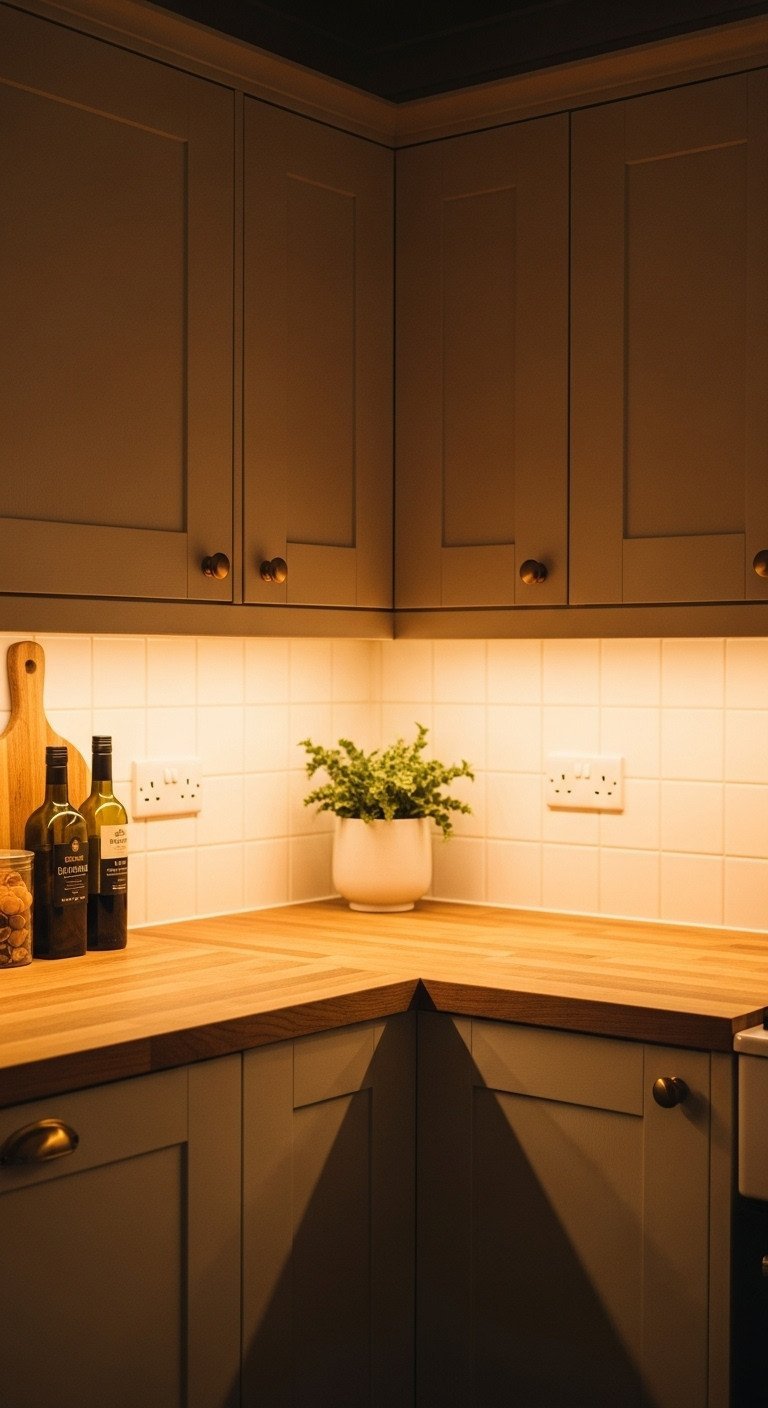As an Amazon Associate KitchenwareSets.com earns from qualifying purchases.
7 Perfect Sage Green And Wood Kitchen Pairing Secrets
Struggling to create a kitchen that feels both on-trend and timeless? You’re not alone. The fear of choosing a design that looks dated in a few years is real, especially with a major investment like a kitchen renovation.
You’ve fallen for the calming, earthy aesthetic of a sage green and wood kitchen. This design concept is defined by the contrast between a cool, painted surface (sage) and the warm, raw texture of natural wood. The core challenge is getting the balance just right to avoid common design mistakes.
A sage green and wood kitchen is a timeless design choice because it leverages biophilic principles, pairing a neutral, nature-inspired color with a classic, warm material. This guide reveals the 7 secrets you need to master this combination, ensuring your kitchen is a sophisticated, enduring space you’ll love for years.
Are Sage Green And Wood Kitchens Timeless, Or Just A Trend?
Sage green and wood kitchens are considered timeless because the combination leverages biophilic design principles, pairing a neutral, naturally occurring color (sage) with raw, warm materials (wood). When managed correctly, this contrast between cool paint and warm texture ensures the aesthetic remains classic and enduring, unlike more vibrant trends.
The secret to its longevity lies in its connection to nature. Biophilic design, which is the practice of connecting people and nature within our built environments, confirms that combining botanical colors like sage with raw materials like wood enhances the restorative quality of a room. Sage green is a soft, grey-green hue with low saturation, giving it a calming, neutral base. Wood introduces necessary warmth and texture, preventing the cool green from feeling monotonous.
Unlike fleeting, high-saturation colors, this pairing feels grounded and authentic. It reflects a fundamental desire for a calming, personal space, which is a core human need, not just a passing interior design fad.
7 Perfect Sage Green And Wood Kitchen Pairing Secrets For A Flawless Design
Achieving a high-end, harmonious look with sage green and wood requires more than just picking a paint color and a wood sample. It’s about a series of deliberate choices that create a cohesive design. These seven secrets, based on professional design principles and material science, are the blueprint for getting every detail right, from undertones to lighting.
1. The Underrated Power of White Oak and Light Sage

Pin this genius tips to your ‘Dream Kitchen’ board!
This pairing is the safest and most effective way to achieve a bright, modern, and airy Scandi-style kitchen. The neutral undertones of white oak prevent the color clash that can happen with warmer, yellow-toned woods.
Elements Needed:
- Light Sage Green Paint (highly grey-biased, low saturation)
- Rift-Sawn White Oak Veneer for cabinetry or island base (key to minimal, straight grain)
- Simple Shaker or Flat Panel Cabinet Style
- Clean, light-colored countertop (white quartz or Carrara marble)
- Brushed metal hardware (e.g., subtle silver or pewter)
Design Strategy:
- Identify Undertone: Ensure the white oak has zero yellow/red undertones. According to expert consensus, highly neutralized white oak is the safest pairing for most sage shades. Use a clear sealant, not an amber stain, to preserve its natural tone.
- Apply Ratio: To maintain balance, use the 60/40 rule. Apply the sage green to the main perimeter cabinets (60%) and reserve the white oak for the island or open shelving (40%).
- Maximize Light: This combination thrives in light. Pair it with large windows and bright, layered lighting to emphasize the reflective quality of the light sage paint.
- Texture Play: Create visual interest by contrasting the smooth, matte painted sage finish with the visible, natural texture of the white oak grain.
Rift-sawn oak, which features a straighter grain pattern, provides a much cleaner, less rustic look than plain-sawn oak, making it ideal for contemporary designs.
2. Mastering the Dark Contrast with Walnut and Deep Sage

Save this clever organization idea!
For a more formal, dramatic, and sophisticated aesthetic, pairing a deep, saturated sage green with the rich, dark tones of walnut creates a stunning high-contrast look. This combination is perfect for modern designs that emphasize clean lines and material quality.
Elements Needed:
- Deep, High-Saturation Sage Green Paint (e.g., a hunter-green adjacent sage)
- Natural Walnut or Dark Walnut Stained Maple
- Flat Panel (Slab) Cabinet Doors (to emphasize the material over the profile)
- Highly reflective backsplash (e.g., glossy Zellige or marble tile)
- Gold or copper hardware
Design Strategy:
- Allocate Contrast: Apply the deep sage to one set of cabinets (either upper or lower), using the rich walnut for the other half. Alternatively, use walnut for a large, separate feature like a pantry unit or hutch to make it a focal point.
- Formality Focus: Walnut is naturally more formal than oak. Maintain this by selecting sleek, flat-panel cabinets and minimal ornamentation to let the materials speak for themselves.
- Mitigate Darkness: To prevent the room from feeling small or gloomy, ensure significant light elements are included. White marble countertops and a highly reflective backsplash are essential to bounce light around the space.
- Utilize Warm Light: Install powerful, warm LED lighting (around 2700K) to bring out the beautiful red and orange undertones in the walnut, which enhances its richness against the cool sage.
Walnut is highly sensitive to UV light and can lighten over time. Ensure all walnut elements are treated with a UV-protective sealant for long-term color integrity.
3. The Brass and Black Hardware Strategy

Pin this detail shot to your ‘Kitchen Hardware’ board!
Hardware is the jewelry of your kitchen. The right metal finish can either amplify the warmth of the wood or provide a sharp, modern contrast that defines the entire aesthetic.
Products & Tools Used:
- Brushed Brass Cabinet Pulls (amplifies warmth, elegant aesthetic)
- Matte Black T-Bar Pulls (modern contrast, defines lines)
- Screwdriver or cabinet hardware jig (for perfect alignment)
Styling Tips:
- Brass for Warmth: According to expert consensus, you should choose brushed brass or antique gold if your chosen wood has warm, yellowish or reddish undertones. The gold finish echoes the warmth in the wood, creating a cohesive and elegant visual loop.
- Black for Modernity: Opt for matte black or pewter if your wood is very neutral (like rift-sawn white oak) and your design is highly modern. Black provides a crisp, defined contrast against both the matte sage paint and the wood.
- Avoid Chrome: High-shine chrome or stainless steel can often introduce a cool, sharp element that clashes with the natural, earthy vibe of the sage and wood pairing. It’s best to reserve these finishes for appliances or sinks.
- Mix the Metals: For added depth, consider a mixed-metal approach. Use matte black pulls on the sage cabinets and a statement brass faucet or pendant light over the wood island. This layering strategy prevents the design from feeling one-dimensional.
Always choose hardware with a slightly matte or brushed finish. High-gloss metals can clash with the low-saturation, matte nature of quality sage cabinet finishes.
4. Balancing Wood Grain with Shaker vs. Flat Panel Cabinets

Save this comparison to your ‘Kitchen Style Guide’ board!
The style of your cabinet door is a crucial decision that dictates the overall feel of the kitchen. The key is to balance the “visual weight” of the wood grain with the detail of the cabinet profile.
Elements Needed:
- Shaker Style Cabinet Doors (adds dimension and shadow lines)
- Flat Panel (Slab) Cabinet Doors (emphasizes color, minimal detail)
- Wood with High Visual Weight (e.g., highly grained oak or hickory)
- Wood with Low Visual Weight (e.g., plain maple or birch)
Design Strategy:
- High Wood Grain Rule: If your wood elements (like floors or an island) have a busy or prominent grain pattern, choose flat panel sage cabinets. The smooth, simple doors provide a calm visual break, preventing the room from feeling chaotic.
- Low Wood Grain Rule: If your wood has a subtle, low-visibility grain (like smooth maple or birch), choose shaker-style sage cabinets. The shaker profile adds necessary shadow lines and architectural detail, ensuring the painted surfaces don’t appear overly simplistic or flat.
- Farmhouse Focus: To achieve a contemporary farmhouse aesthetic, pair shaker cabinets with a slightly yellow-biased sage and a heavily grained wood like rustic oak.
- Modern Focus: For a crisp, modern look, combine flat panel cabinets with a grey-biased sage and a smooth wood like walnut or rift-sawn oak.
Ensure that if you select flat panel cabinets, the paint quality and application are impeccable. Every slight surface imperfection is highlighted due to the lack of a door profile.
5. The Countertop Secret: Clean Quartz vs. Warm Butcher Block

Pin this aesthetic pairing to your ‘Kitchen Inspiration’ board!
The countertop acts as the bridge between your sage green cabinets and wood accents. Your choice here must balance aesthetic goals with the practical demands of a kitchen, including durability and maintenance.
Materials Needed:
- Low-Maintenance White Quartz Slab (clean, crisp, low-maintenance)
- Butcher Block Wood Slab (authentic warmth, high maintenance)
- High-grade sealant or polyurethane (essential for wood countertops)
- White subway tile or zellige tile (for backsplash neutral break)
Selection Criteria:
- The Neutral Break (Quartz): If you are using sage green cabinets and a prominent wood island, white quartz is the ideal choice for the perimeter countertops. This clean, crisp material provides a necessary neutral break that prevents the sage and wood from overwhelming the room and keeps the space feeling bright.
- The Rustic Anchor (Butcher Block): While beautiful, butcher block is best used as an accent in a rustic farmhouse design. Consider it for a small baking station or a section of the island, as its high maintenance requirements make it less practical for the entire kitchen.
- Safety First: If you opt for butcher block, it must be properly sealed. Industry standards recommend at least two coats of food-safe hard wax oil or polyurethane to achieve the minimum water resistance required in a kitchen environment.
- Match Undertones: When selecting a veined quartz, ensure the veins are grey or brown. Yellowish veins can clash with a neutral, grey-biased sage green, disrupting the color harmony.
Butcher block has a Janka hardness rating typically lower than materials like oak. Be prepared for regular oiling and potential surface repairs, which is part of its rustic appeal but a critical factor in long-term durability.
6. Solving the Small Space Dilemma with Vertical Wood Shelving

Save this clever organization tips!
You can absolutely achieve the sage green and wood look in a small or poorly lit kitchen. The secret is to use color and materials to create an illusion of height and space, rather than filling the room with bulky elements.
Materials Needed:
- Light, Grey-Biased Sage Green Wall Paint (higher light reflectivity)
- Floating White Oak Shelves Heavy Duty (ensures structural integrity)
- Heavy-duty shelf brackets or support rods (hidden hardware preferred)
- Level and stud finder
Step-by-Step Directions:
- Swap Cabinets for Paint: Instead of bulky upper cabinets that can make a small kitchen feel cramped, paint the entire wall space above the counter in a light sage green. This introduces the color element without the physical mass of cabinetry.
- Install Shelves: Locate the wall studs and install minimal, open wood shelving. Ensure the shelves run close to the ceiling to draw the eye upward, creating a powerful perception of height.
- Curate Items: Visual clutter is the enemy of small spaces. Only place essential, aesthetically pleasing items on the shelves, such as white dishes, glass jars, and small plants.
- Distribution of Wood: This strategy helps distribute the wood tones vertically. If you have natural wood lower cabinets, the open shelving creates balance. If you have sage lowers, the shelves become the primary wood accent.
Use the lightest possible shade of sage green (one with a high Light Reflectance Value, or LRV) in small kitchens with minimal natural light. Dark colors recede and can make small spaces feel even smaller.
7. Lighting is the 8th Color: Maximizing Warm LEDs and Natural Light

Pin this cozy lighting tip to your ‘Kitchen Renovation’ board!
Lighting is a critical, often-overlooked element that can make or break your design. The wrong light temperature can make your sage green look cold and muddy while washing out the natural warmth of the wood.
Equipment Needed:
- Dimmable LED Strip Lights (low profile, easy to install)
- Warm LED Lighting Kit (2700K-3000K)
- Smart switch or dimmer control
- Diffuser channels (to eliminate visible hot spots from LEDs)
Implementation Steps:
- Choose Warm Light: Select LED bulbs or strips in the 2700K to 3000K temperature range. Cool, blue-toned lighting (4000K and above) will pull the grey undertones out of the sage, making it look cold and sterile while canceling out the wood’s inviting warmth.
- Layer the Light: A well-lit kitchen incorporates three layers of light: general (ambient overhead lighting), task (under-cabinet lighting), and accent (a pendant over the island). Task lighting is especially crucial for properly illuminating the sage cabinets and wood countertops.
- Maximize Natural Light: If your kitchen has low natural light, use a slightly darker, more saturated sage green. Paradoxically, a deeper color will hold its own better, whereas a very light sage can look greyed-out and muddy in dark rooms.
- Use Dimmers: Install dimmers on all lighting circuits. The ability to adjust the light’s intensity is key to making the sage and wood tones look perfect whether you’re prepping a meal, cleaning up, or enjoying a quiet evening.
Install low-profile LED strips under ALL upper cabinets and inside any open shelving. This not only improves functionality but dramatically changes the perceived warmth of the wood elements after sunset.
Key Takeaways: Your Quick Guide to Flawless Sage and Wood Design
Achieving a professional-quality sage green and wood kitchen comes down to a few core rules. Keep this checklist handy as you plan your project.
The Designer’s Checklist for Sage Green and Wood Kitchens
- Undertone Matching is Non-Negotiable: Always check your wood’s undertones (yellow/red) against the sage paint swatch (grey/beige). Use a grey-based sage to neutralize the warmth of oak and prevent clashing.
- Stick to the 60/40 Ratio: Use 60% of the room’s surfaces for the primary color (usually sage cabinets or walls) and 40% for the natural wood accents (island, shelves, flooring) to maintain visual balance.
- Use Hardware to Connect: Select brushed brass hardware to amplify the wood’s warmth, or matte black hardware for a high-contrast, modern link between the cool sage and the wood texture.
- Prioritize Wood Quality: For long-term durability and aesthetic, opt for highly resilient wood species like Oak (Janka rating above 1200) and ensure all elements near water are properly sealed.
People Also Ask About Sage Green and Wood Pairing
Is the sage green and wood combination going to look dated soon?
Highly unlikely; the sage green and wood pairing is a design classic, not a fleeting trend. Because sage green is a low-saturation, nature-inspired color (biophilic design) and wood is a raw, enduring material, this combination has a natural timelessness that withstands rapid trend shifts.
What are the specific undertones I need to worry about when choosing wood?
The critical factor is preventing the wood’s inherent yellow or orange undertones from clashing with any yellow undertones in the sage paint. Always select a sage green with a distinct grey or beige bias. Test paint samples directly against your wood to ensure the colors do not compete.
How can I make my sage green and wood kitchen look modern instead of rustic?
To achieve a modern look, prioritize clean lines and high contrast. Choose flat-panel (slab) cabinets over shaker, opt for smooth woods like walnut or rift-sawn oak, and use high-contrast matte black hardware. Keep the surrounding elements (backsplash, counters) clean and white.
Is it expensive to refinish old wood cabinets in sage green?
Refinishing existing cabinets is often significantly less expensive than replacing them entirely. The cost savings are high, but the time investment and labor for proper prep (sanding, degreasing, priming) are substantial to ensure a durable, professional-quality finish that lasts 10-15 years.
Final Thoughts
Sage green and wood are not merely a current trend; they represent a fundamental desire for a calming, grounded, and deeply personal space. By applying these 7 secrets—from meticulously matching undertones and leveraging the visual weight of your wood species to strategically lighting your space—you move past superficial design and create a kitchen that feels effortlessly warm and sophisticated for decades. Your kitchen renovation is a major investment; use this guide as your blueprint to ensure every element, from the smallest brass pull to the largest wood grain, achieves perfect harmony.
Which of these 7 pairing secrets are you most excited to implement in your 2025 kitchen design? Let us know in the comments
Last update on 2025-12-15 at 18:57 / Affiliate links / Images from Amazon Product Advertising API
